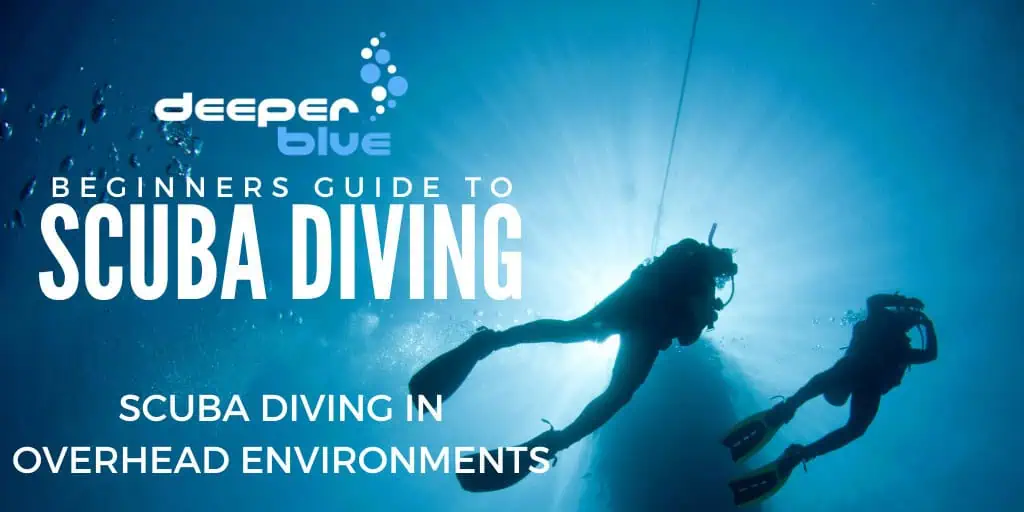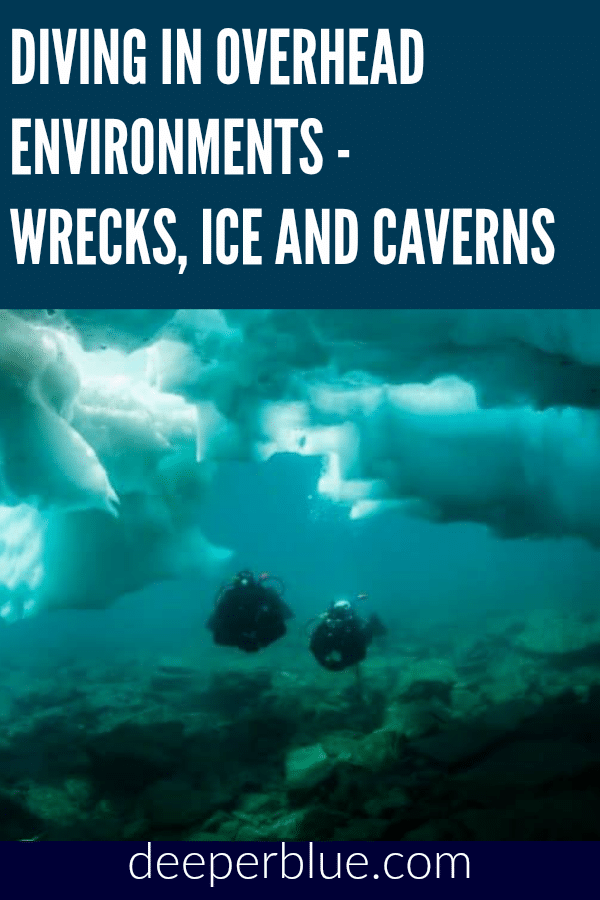This article is part of the Beginners Guide to Scuba Diving
Visiting a reef that has taken over a sunken ship can be an exhilarating adventure for any diver. As you follow along the reef, you will notice the man-made parts of the reef that was once the ship. An open hatch or companionway might beckon you to be further explored. Or it might be beckoning you to your death. Diving in some environments, like penetration into a wreck, take special skills, skills not a part of being an OWD or AOWD. If you cannot ascend directly to the surface, it is beyond your training.
Anytime you are in an environment that does not allow direct ascent to the surface it is called an overhead environment and requires special training. Recreational scuba divers can be trained in three different overhead environments, Wreck diving, Cave diving, and Ice diving. They have many things in common but each has some unique risks.
Recreational Scuba divers can train for these environments to the limit of the light zone. This means that you can still see daylight at the entrance. If they travel horizontally into an overhead, the distance counts in their distance from the surface. An Advanced Open Water Diver can dive to 100ft/30m, If they enter an overhead environment at 90ft/27m then they can only travel 10ft/3m even if the light zone extends further.
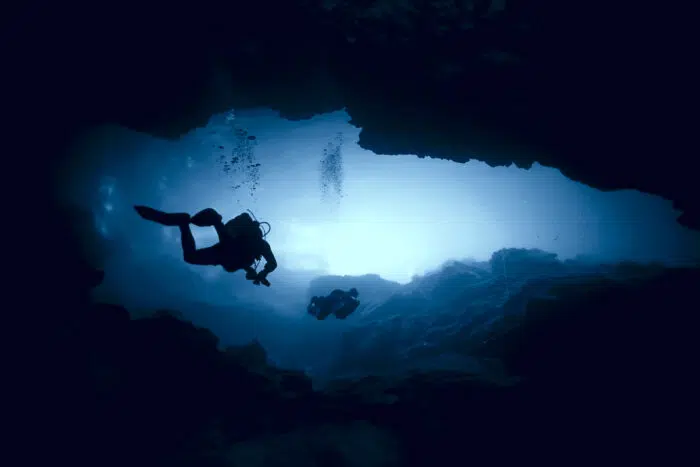
What is Cave Diving
Cave diving is a type of scuba diving that takes place in underground caverns and caves. It can be a dangerous activity, as the underwater cave systems can be difficult to navigate and have many hazards. Cave diving isn’t something you do without adequate knowledge because there are many hazards involved, but for divers who are experienced and know how to safely navigate these environments, cave diving can be an incredibly rewarding experience.
Many people cave dive just for fun or as a form of recreation, but it can also be an important skill for professional cave rescuers, archaeologists, and biologists.
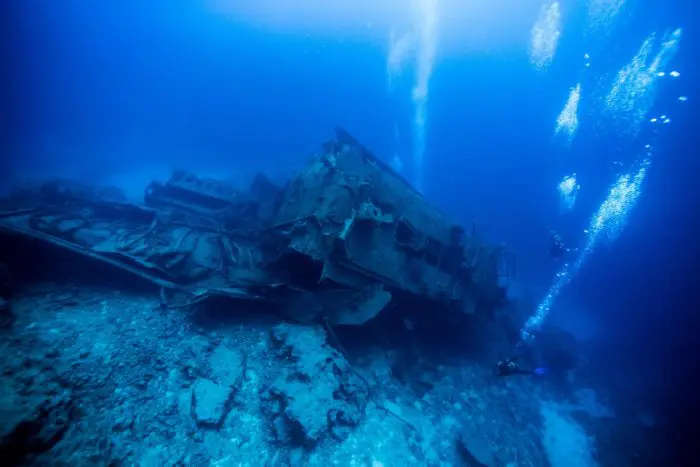
What is Wreck Diving
Wreck diving refers to the exploration and examination of shipwrecks. The activity usually takes place while Scuba Diving, which allows divers to explore wrecks at greater depths than would be possible with snorkeling. Many wrecks are popular dive sites because they are well preserved and offer a wide variety of marine life. Divers can find all sorts of items in wrecked ships, from furniture and tools to medical equipment and dolls. Some wreck divers even seek out ghost ships, which are boats that have been lost at sea for many years.
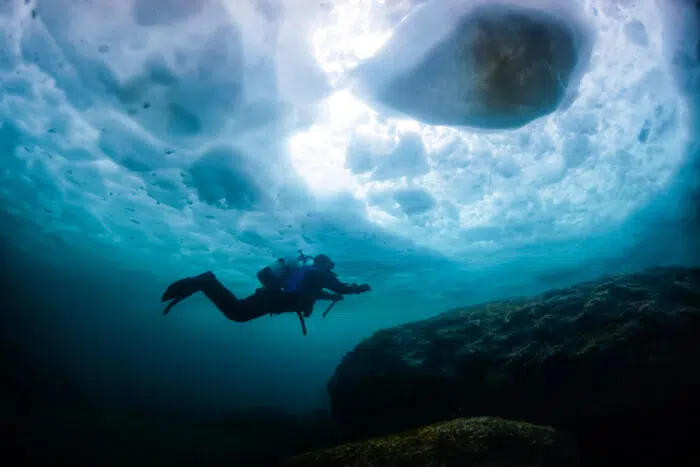
What is Ice Diving
If you’re a scuba diver, you may have heard of ice diving – but what is it, exactly? Ice diving is a form of scuba diving where divers explore underwater caverns and formations that are covered or underneath the ice. This can be an incredibly exhilarating experience, but it’s important to remember that ice diving requires specialized training and equipment. If you’re interested in giving ice diving a try, be sure to do your research first and find a reputable dive operator.
Rules to follow while Cave Diving, Ice Diving or Wreck Diving
Here are a few of the items a scuba diver who is going cave diving, wreck diving, or ice diving needs to know about.
Rule of Thirds
The technical divers who specialize in cave diving have a procedure they call the rule of thirds. Simply put, they plan their dive to use 1/3 of their breathing gas traveling into the cave and allocate 1/3 to leave the cave and return to the surface. The remaining 1/3 is an emergency reserve. Once they leave the cave, they can treat the dive as a normal dive and use the remaining breathing gas as they see fit. This procedure has been adopted by recreational divers in overhead environments as well.
Reels and Lines
A cave diver will not enter a cave without running a line or following a permanent line. This is another trait the recreational divers have adapted. Even if you are in the light zone, things can happen to get you lost. If you get lost, you can only stay lost for a little while. Once you use your air, you are dead. That is why training is required for dives of this nature.
The training program will teach you the proper use of a reel to lay your line going in and to retrieve it as you leave. The lead diver will lay the line and secure it at points as they go it. The other divers will follow and maintain contact with the line or at most just a reach away. On the way out, the diver with the reel will be last.
Buoyancy Control
While buoyancy control is always important, in an overhead environment it is critical. Poor buoyancy control can easily lead to silt-out conditions as described next. However, there are other hazards that increased this. You may find yourself in confined spaces, and poor control could have you brush against a sharp piece of metal in a wreck, resulting in an injury or ruin BCD. Becoming positively buoyant might cause you to float up above your exit point and you need to work hard to get down.
Silt-Outs
Generally, overhead environments are subject to little or no currents. They also have a fine layer of silt that is easily disturbed. A bad fin kick can create a cloud of silt so thick that you cannot see your hands. On a reef, you can just rise above it and let the water disperse it. In an overhead environment, that generally will not happen. A silt out can last for a few minutes to hours, meaning you will need to find your way out in no visibility, as there is no way to tell how long it will last. If the silt out is behind you, remember you need to return in that direction. Silt outs are the number one reason contributing to a diver becoming lost.
The Overhead Diving Specialties
There are a number of specialty courses you can take from a number of scuba diving certification agencies.
Wreck Diving
The wreck diving specialty is the most common of the three overhead courses. The PADI wreck diver specialty splits its training between wreck-orientated work outside the wreck and skills for penetration. The first two dives involve mapping a wreck site and tasks related to the artificial reef. The third dive concerns laying the reel and tasks related to entering and exiting a wreck. The fourth dive is the penetration dive, however, the skills can be done outside the wreck if the site is not suitable for penetration. SSI has a wreck course, however, their course does not include penetration dives. SSI has a separate course called Advance Wreck Diving, that provides more in-depth training to penetrate wrecks.
Cavern Diving
A simple definition is in order before continuing. The word “cavern” in diving is used differently than the proper definition of the word. A Cave is defined as an underground hollow space and a cavern is defined as two or more caves connected by a passage. In diving, the cavern means a portion of a cave entrance that has natural lighting. We have an overhead between us and the surface but can still see the daylight. There are many places to dive caverns around the world. The most popular are the Cenotes of Mexico and the Springs of Florida. Both of these locations also feature extensive cave systems for technical divers.
The specialty course for Cavern diving is more intense than the wreck course. The knowledge portion is larger. The conditions that can cause silt out are different and each is explored. The type of cave will at times influence the dive, so divers learn about the development of cave and their nature. The course has one shallow dive to learn and practice the reels and four penetration dives. Buoyancy control is also practiced during each dive.
Ice Diving
Ice diving presents some challenges that the other two overhead environment does not. In a wreck or cavern, you dive within the light zone, you can see the light. When you reach it, you follow the light source and have a clear route to the surface. In Ice diving, following the light source may only take you to the ice. Your exit may be very small, located somewhere in that ice. Plus the nature of the water is cold.
Much of the practical portion of the ice diver courses are done at the surface. Ice divers need a good surface support team and the ice diver training includes those tasks as well. While we might think of ice as ice, it is not true. There are different characteristics of the ice coverage you may encounter and the diver must be prepared for them. Ice divers require dry suits and you must be proficient in the dry suit and comfortable in cold water diving before going under the ice. While all overhead environments have a physiological aspect, it is strongest in ice diving.
Overhead Diving
Only a small percentage of divers train for overhead diving. Those that do have a whole new set of adventures available for them. If you want a taste of an overhead environment, then a dive in one of the Mexican Cenotes might be a great option. The Cenotes are dived with certified cave divers as guides and can take certified divers on a tour as an adventure dive if they are not certified, cavern divers. It is a unique experience waiting for you.
Click here for more articles in the Beginners Guide to Scuba Diving

